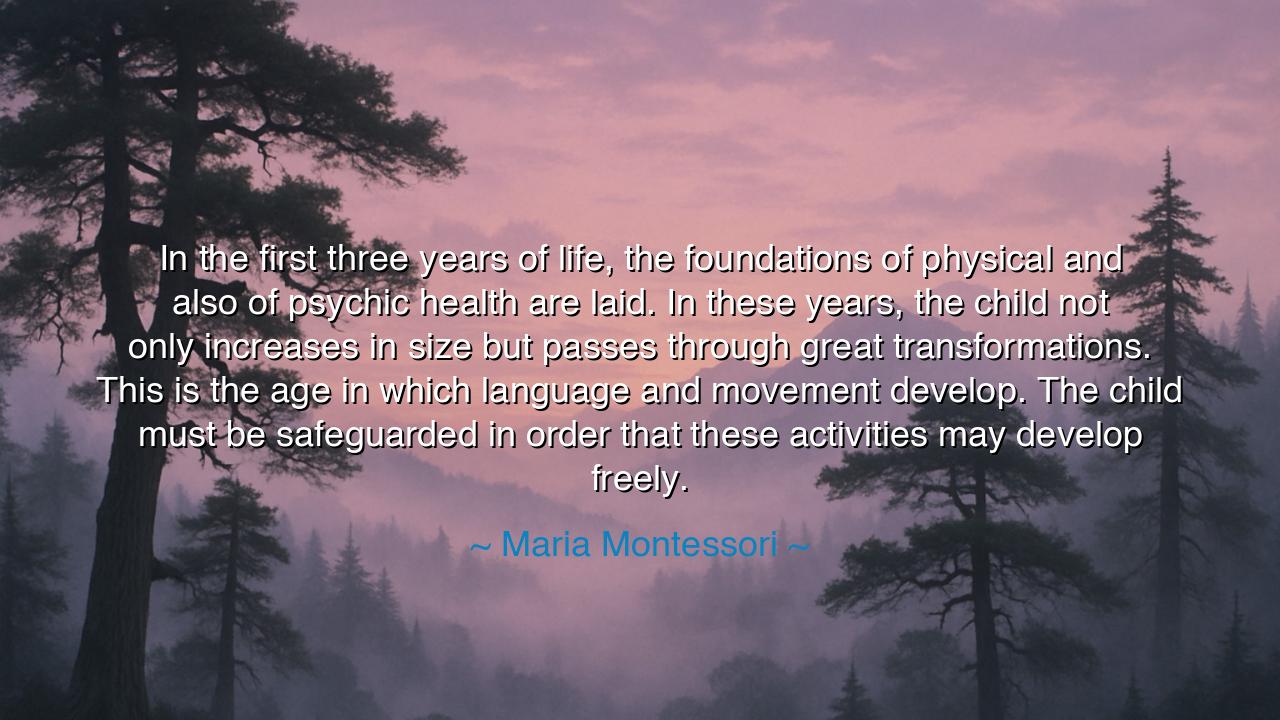
In the first three years of life, the foundations of physical and
In the first three years of life, the foundations of physical and also of psychic health are laid. In these years, the child not only increases in size but passes through great transformations. This is the age in which language and movement develop. The child must be safeguarded in order that these activities may develop freely.






When Maria Montessori proclaimed, “In the first three years of life, the foundations of physical and also of psychic health are laid. In these years, the child not only increases in size but passes through great transformations. This is the age in which language and movement develop. The child must be safeguarded in order that these activities may develop freely,” she spoke as one who understood the sacred architecture of human becoming. Her words carry not the tone of mere education, but of creation itself. In the earliest years, she tells us, the spirit of the child is still forming, shaping its roots in both body and soul. To tend to a young child, then, is to stand at the threshold of destiny—to mold not just a being of the present, but the potential of an entire life.
Montessori’s insight was born not from theory alone, but from observation. She watched children with the patience of a philosopher and the reverence of a gardener, seeing in them the unfolding of a cosmic pattern. The first three years—often dismissed by adults as simple infancy—are, to her, the most powerful of all. During this time, the child absorbs the world without effort, through what she called the “absorbent mind.” Every sound, every motion, every touch becomes a brick in the temple of the self. Here, the foundations of language, movement, and emotion are formed, shaping how a person will speak, think, and feel for the rest of their days.
In the ancient sense, this is the season of beginnings, when the soul first learns the rhythm of existence. The body, fragile yet full of promise, learns strength through motion. The mind, untainted by fear, drinks in wonder from its surroundings. And the heart, untouched by cynicism, forms its first bonds of trust or doubt. To harm or neglect the child in this time is to wound the very roots of humanity; to nurture and protect them is to build the future upon firm and sacred ground.
History offers a mirror to Montessori’s vision in the story of Helen Keller. Deaf and blind from infancy, she was locked away from communication until the age of seven. But when Anne Sullivan entered her life, the miracle of language unfolded within her like dawn breaking over night. Keller’s transformation proved that the human spirit hungers for connection and meaning even before it can speak. Though her development began late, her story echoes Montessori’s truth: the child’s early years are the seedbed of mind and soul, and when nurtured with love and patience, they bloom into brilliance.
Montessori’s call to “safeguard the child” is thus a moral and spiritual commandment. She does not mean to shield children from all struggle—for struggle itself is how strength is born—but to protect the sacred process of natural growth. To safeguard is to provide an environment of safety, love, and freedom—where curiosity is not punished, where exploration is encouraged, and where independence blossoms without fear. For in such soil, the young spirit develops harmony between body and psyche, between the will and the world.
Yet the tragedy of modern life is that we rush the child, drowning their sacred years in noise, screens, and anxious ambition. We mistake growth for acceleration, and structure for wisdom. Montessori reminds us that the child does not need to be filled—they need to be allowed to unfold. The duty of parents, teachers, and societies is not to command, but to guide; not to shape by force, but to prepare the environment where the miracle of development can happen naturally.
In her schools and writings, Montessori wove this philosophy into practice. The Montessori method, still alive across the world, is not just an educational system—it is a living testament to respect for the child’s inner rhythm. She believed that if humanity wished to heal itself, it must begin not with politics or war, but with the quiet revolution of childhood. Every act of kindness toward a child, every moment of patience and encouragement, becomes a thread in the tapestry of peace.
Final Lesson: The early years of life are sacred ground. To nurture a child is to shape the destiny of humanity itself.
Practical Actions: Protect the freedom of every child to explore, to move, to wonder. Speak to them with patience and truth. Create environments of beauty, calm, and safety where growth can occur naturally. And remember always: to guide a child well is to build the foundation of a wiser, gentler world—for in the first three years, the roots of the human soul are planted forever.






AAdministratorAdministrator
Welcome, honored guests. Please leave a comment, we will respond soon